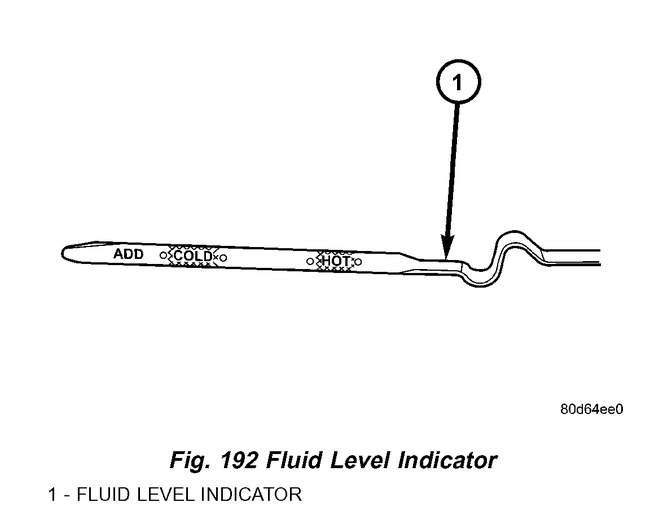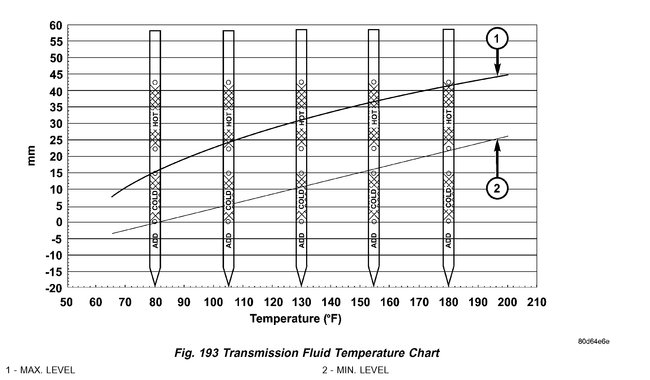Hi,
Tia, have you checked the transmission fluid level? It expands with heat, so there is a chance it is just low.
Also, is the check engine light staying on when the engine is running?
Here are the directions for checking fluid level and condition. Note that it should be checked when the engine is running and at operating temp.
____________________________________
2003 Chrysler Truck PT Cruiser L4-2.4L VIN B
Fluid Level and Condition Check
Vehicle Maintenance Fluids Fluid - A/T Service and Repair Procedures 41TE Fluid Level and Condition Check
FLUID LEVEL AND CONDITION CHECK
STANDARD PROCEDURE - FLUID LEVEL AND CONDITION CHECK
NOTE: Only transmission fluid of the type labeled Mopar ATF +4 (Automatic Transmission Fluid-Type 9602) should be used in this transaxle.
FLUID LEVEL CHECK
The transmission sump has a fluid level indicator (dipstick) to check oil similar to most automatic transmissions. It is located on the left side of the engine. Be sure to wipe all dirt from dipstick handle before removing.
Pic 1
The torque converter fills in both the P Park and N Neutral positions. Place the selector lever in P Park to be sure that the fluid level check is accurate. The engine should be running at idle speed for at least one minute, with the vehicle on level ground. At normal operating temperature 82°C (180°F), the fluid level is correct if it is in the HOT region on the oil level indicator (Fig. 192). The fluid level should be within the COLD region of the dipstick at 27°C (80°F) fluid temperature.
FLUID LEVEL CHECK USING DRB
NOTE: Engine and Transaxle should be at normal operating temperature before performing this procedure.
1. Start engine and apply parking brake.
2. Hook up DRB scan tool and select transmission.
3. Select sensors.
4. Read the transmission temperature value.
Pic 2
5. Compare the fluid temperature value with the fluid temperature chart (Fig. 193).
6. Adjust transmission fluid level shown on the indicator according to the chart.
7. Check transmission for leaks.
Low fluid level can cause a variety of conditions because it allows the pump to take in air along with the fluid. As in any hydraulic system, air bubbles make the fluid spongy, therefore, pressures will be low and build up slowly.
Improper filling can also raise the fluid level too high. When the transaxle has too much fluid, the gears churn up foam and cause the same conditions, which occur with a low fluid level.
In either case, air bubbles can cause overheating and/or fluid oxidation, and varnishing. This can interfere with normal valve, clutch, and accumulator operation. Foaming can also result in fluid escaping from the transaxle vent where it may be mistaken for a leak.
FLUID CONDITION
Along with fluid level, it is important to check the condition of the fluid. When the fluid smells burned, and is contaminated with metal or friction material particles, a complete transaxle recondition is probably required. Be sure to examine the fluid on the dipstick closely. If there is any doubt about its condition, drain out a sample for a double check.
Mopar ATF +4 (Automatic Transmission Fluid Type 9602) when new is red in color. The ATF is dyed red so it can be identified from other fluids used in the vehicle such as engine oil or antifreeze. The red color is not permanent and is not an indicator of fluid condition. As the vehicle is driven, the ATF will begin to look darker in color and may eventually become brown. This is normal. ATF +4 also has a unique odor that may change with age. Consequently, odor and color cannot be used to indicate the fluid condition or the need for a fluid change.
After the fluid has been checked, seat the dipstick fully to seal out water and dirt.
_________________________________________________________
Let me know what you find.
Joe
Images (Click to make bigger)
Tuesday, November 26th, 2019 AT 7:19 PM




